Webflow vs. WordPress: The Ultimate Comparison
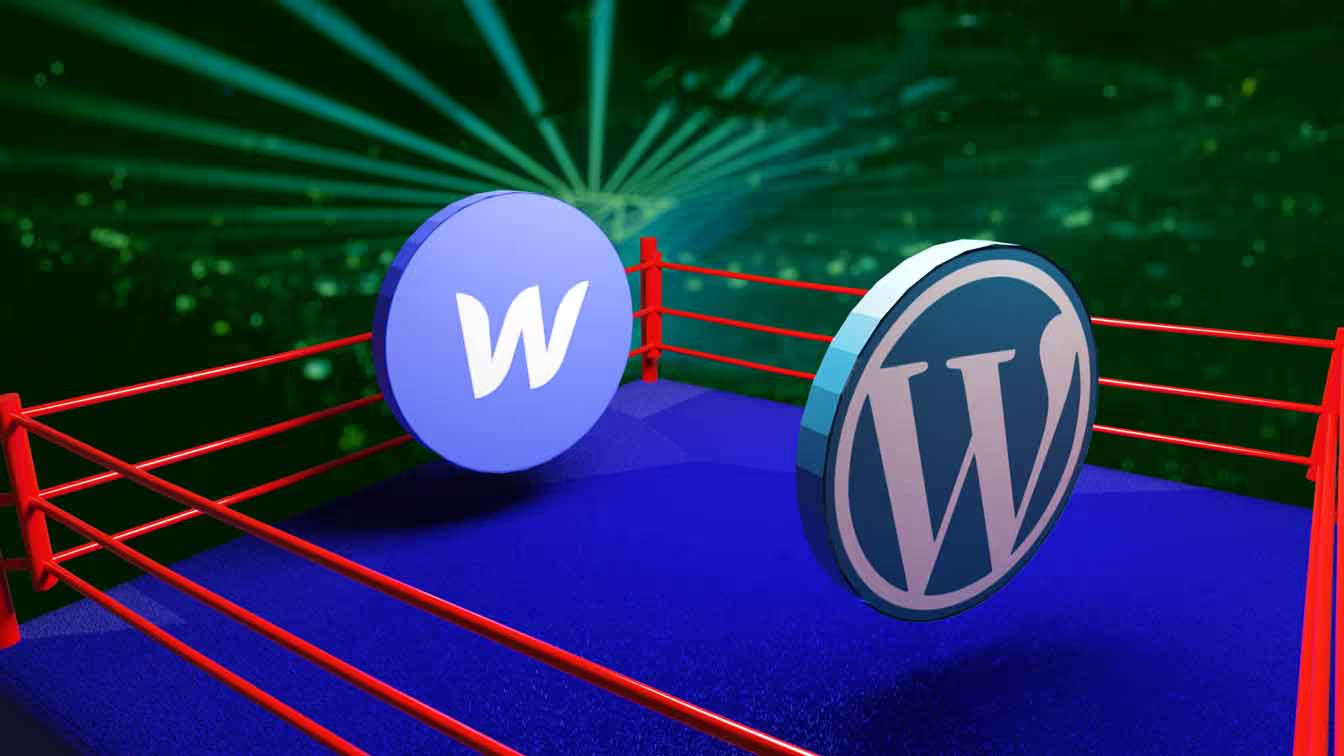
Which is better in 2023: Webflow or WordPress?
This is the most in-depth comparison of the two platforms.
Quick Takeaways:
- Webflow is better than WordPress in terms of design customization, code cleanliness, and animations. WordPress beats out Webflow with 3rd party integrations and ease of use for beginners.
- Webflow can be a replacement for WordPress in some circumstances, but not all, as WordPress still has certain advantages over Webflow.
- Both WordPress and Webflow can make beautiful and profitable websites. Which one to use depends on your needs.
Skip to sections:
- Design
- Pricing
- SEO
- Pagespeed
- CMS and Blogging
- 3rd Party Plugins and Integrations
- Animations and interactions
- Hosting
- Difficulty to Learn
- eCommerce
- Staging
- Technical Support
Section 1
Design
Let's compare the design tools that come with Webflow versus the wide assortment of tools available for use with WordPress.

Webflow Design:
Webflow comes with a page builder that allows for completely custom designs.
You can start from scratch or start with a template and build out from that (templates cost extra).
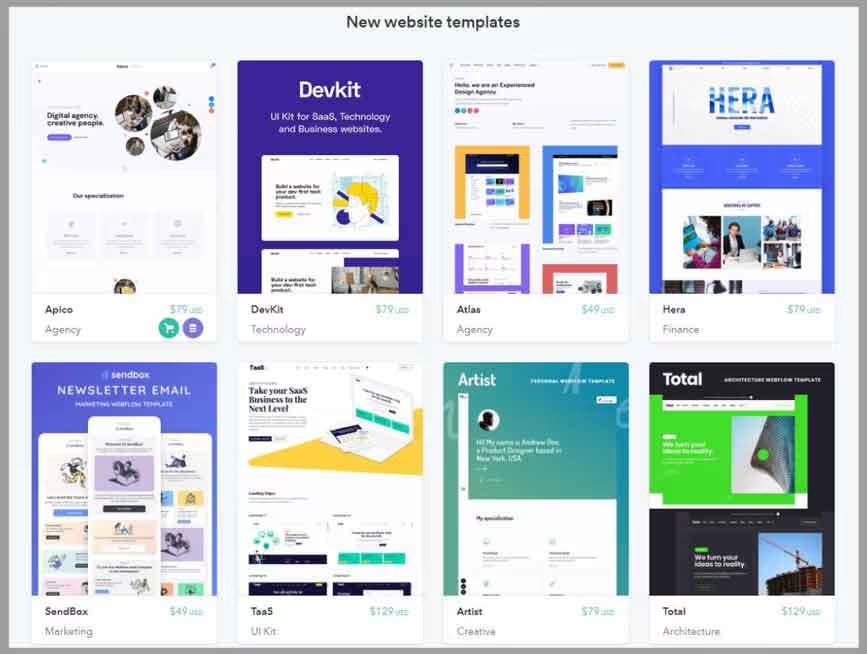
You do not need to have coding experience to use Webflow, however, it is good to know how coding elements work together.
For example, the flex box is a regularly used feature, and it decides how elements are arranged within sections. Without any prior knowledge of the flex box, it could be quite irritating trying to figure it out on your own.
The designer itself could be a bit intimidating upon first view. There are dozens of options and settings thrown at you immediately, and it can take some time getting used to where everything is and how it all works together.

Stanley Sigalov
Owner
105 West Design
"I was able to transition my team to a no-code environment while retaining the same amount of flexibility and transparency as designing through coding. While there are tools that allow (almost) as seamless of a workflow on WordPress, the experience is much more native on Webflow. Everything just works together, from the hosting, to the CMS, to every pixel on the screen."
WordPress Design:
WordPress has three options for developing and designing your website.
- Have it built from scratch with custom code
- Use a premade theme
- Use a page builder theme or plugin
Custom coding the website allows for complete customization, but there is one obvious downside. If you decide to have the website built from scratch with code, you will have to hire a developer every time they need something tweaked or updated.
There are some good premade templates, but there is a limit to how much you can customize them.
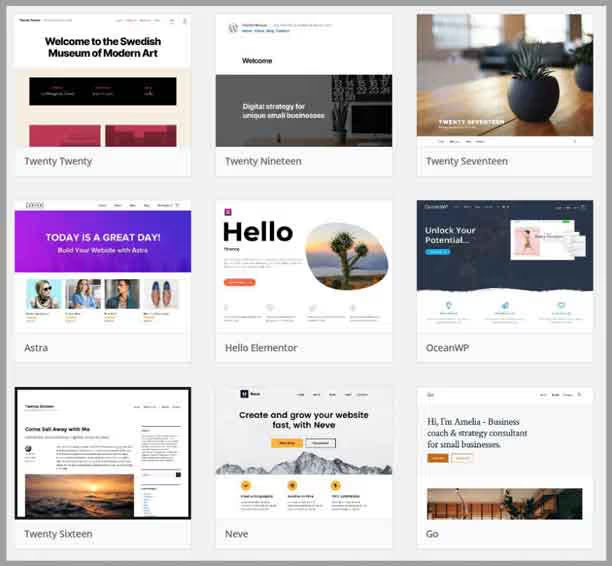
And if you do decide that you want something updated outside of the realm of the template theme, you will probably end up having to hire a developer to find a solution.
This leaves us with the last option, which is most often used by agencies...
And that is page builders, such as Elementor, Divi, Visual Composer, Beaver Builder, Thrive, and others.
These page builders allow you to create custom designs from scratch without needing to know anything about coding.

In contrast to template themes, these page builders are highly customizable.
For the sake of this article, I’m going to be focusing on template themes and page builders, as that is the most common use of WordPress today.
Takeaway:
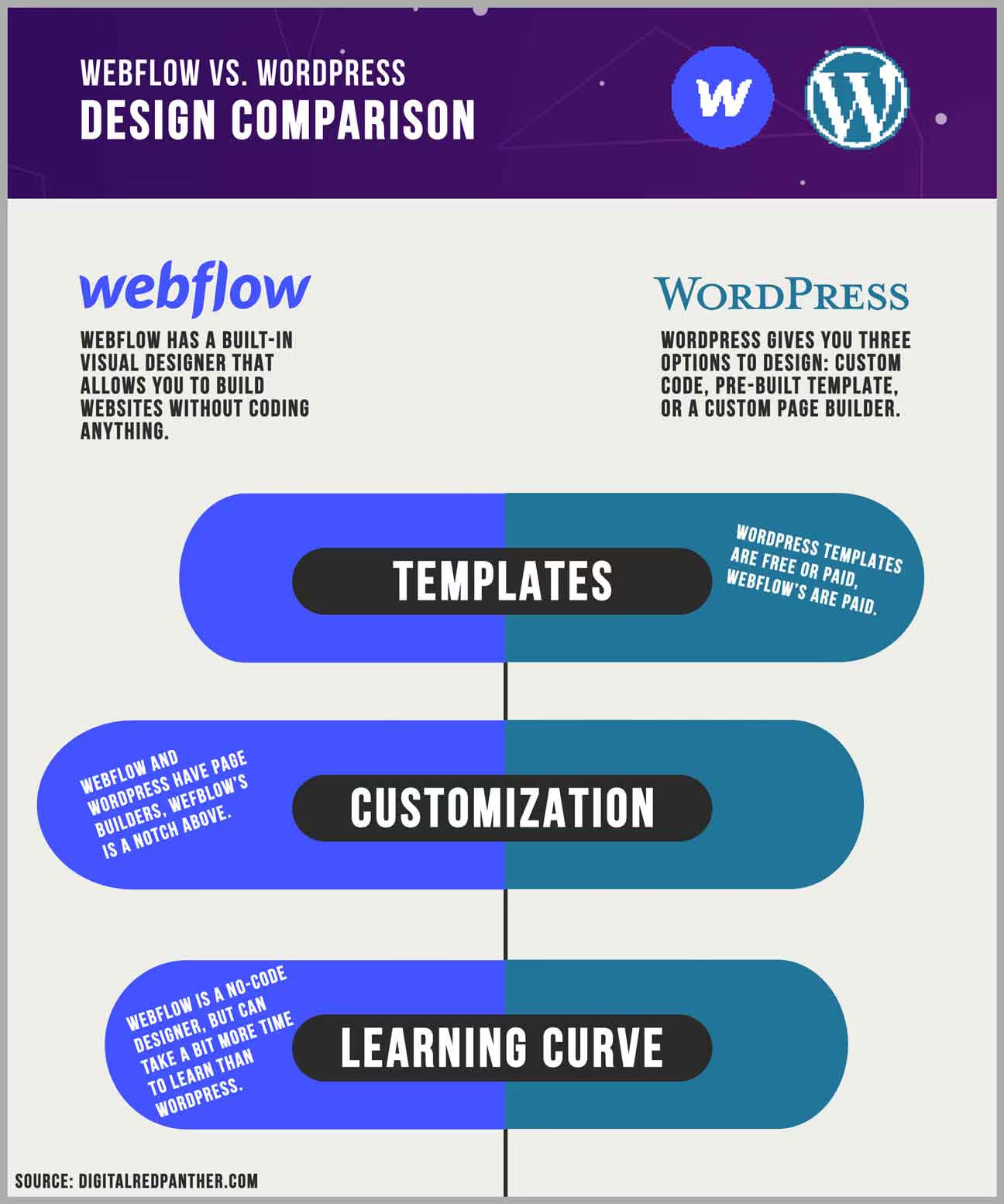
Whether you use Webflow or WordPress, both options allow for completely customized designs.
The interfaces are different, and it really depends on personal preference which one is best.
Webflow may have a leg up on actually how much customization you can do, but the WordPress page builders are right behind.
Section 2
Pricing
The cost structure of Webflow and WordPress are different.Since they are based on different models, we'll have to do some critical thinking on which is the better investment for your business.

Webflow Pricing:
Webflow’s pricing model is a bit confusing at first glance, but there is a reason for that. They have site plans, account plans, and eCommerce plans. Each fulfills a different need. For today's purpose, let's look at the site plans. (FYI- account plans are not required to launch your website.)
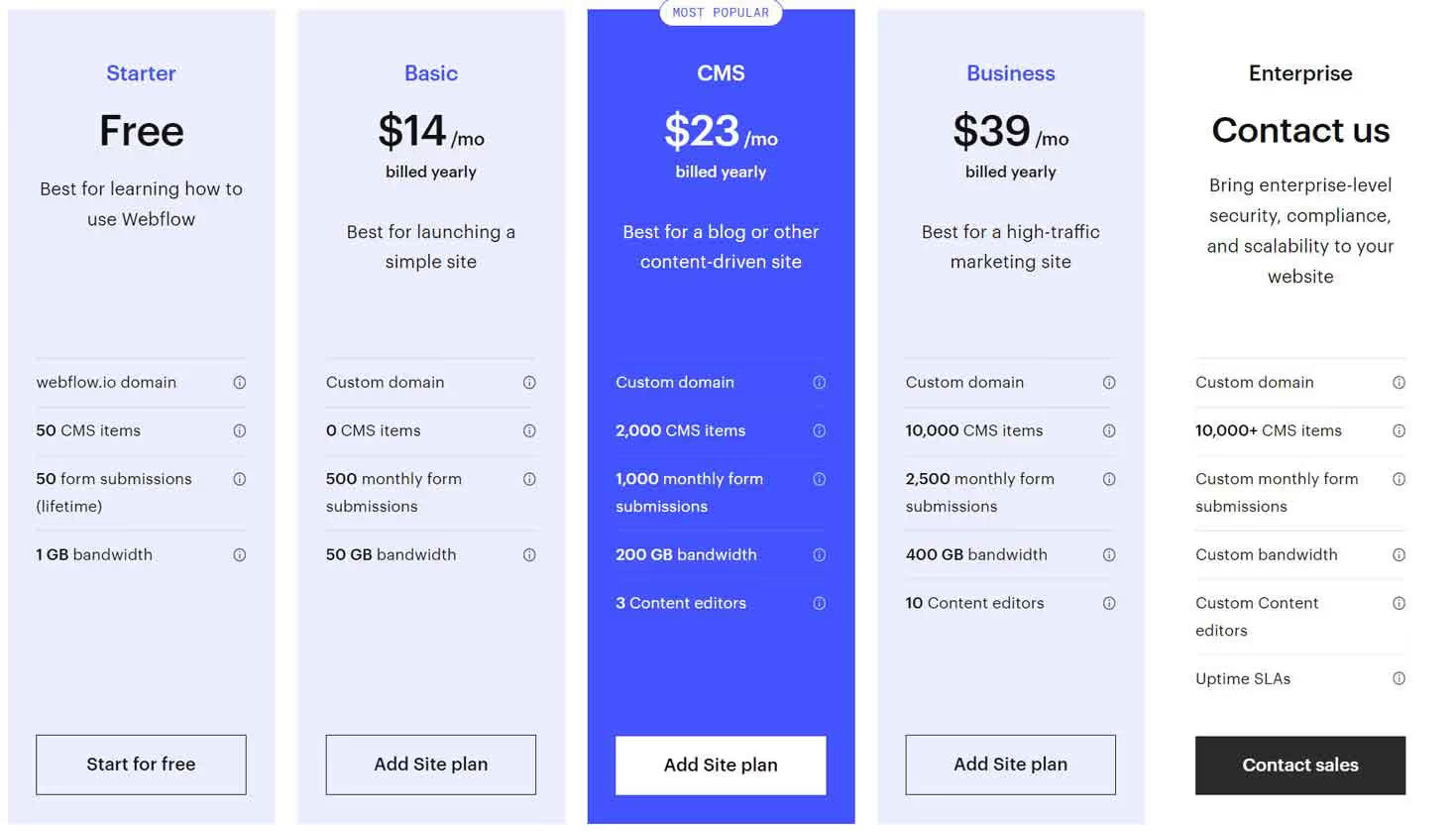
Most businesses simply need to decide between the Basic plan and the CMS plan. The main difference is that the CMS plan includes a system to dynamically add blog posts to the website, whereas the Basic plan does not include that.
Basic: $14 per month = Hosting, free SSL certificate, CDN, 25,000 monthly visits, and 500 monthly form submissions.
CMS: $23 per month = Hosting, free SSL certificate, CDN, 100,000 monthly visits, 1,000 monthly form submissions, 2,000 CMS items, CMS API, 3 content editors, and a site search feature.
Business: $39 per month = Hosting, free SSL certificate, CDN, 1,000,000 monthly visits, 2,500 monthly form submissions, 10,000 CMS items, CMS API, 10 content editors, a site search feature, and a form file upload.
If you are purchasing a pre-built template, the price ranges from $24 - $129.
Also, it's worth noting that you can start building your project on Webflow for free, but you must pay before publishing.
WordPress Pricing:
WordPress itself is actually free. However, in order to use WordPress, you will need hosting, a theme, and plugins, all of which may cost money.
- Hosting
WordPress hosting will usually cost anywhere from $3 per month up to $35 per month. The most common WordPress hosting companies used are Bluehost, Dreamhost, InMotion, Siteground, HostGator, WPEngine, just to name a few.
- Theme or Page Builder
If you are going with a pre-built theme, you can purchase one or use a free version. Themes usual cost anywhere from $30 - $100. If you decide to use a page builder, these are a little more expensive. They usually range in the area of $50 - $200 per year.
- SSL Certificate
Some hosting plans include a free SSL certificate, but if that’s not included in yours, then you will need to include that as a cost.
- Plugins
You can easily get by without paying for any premium plugins, but there are some that cost money. Keep that in mind.
Takeaway:
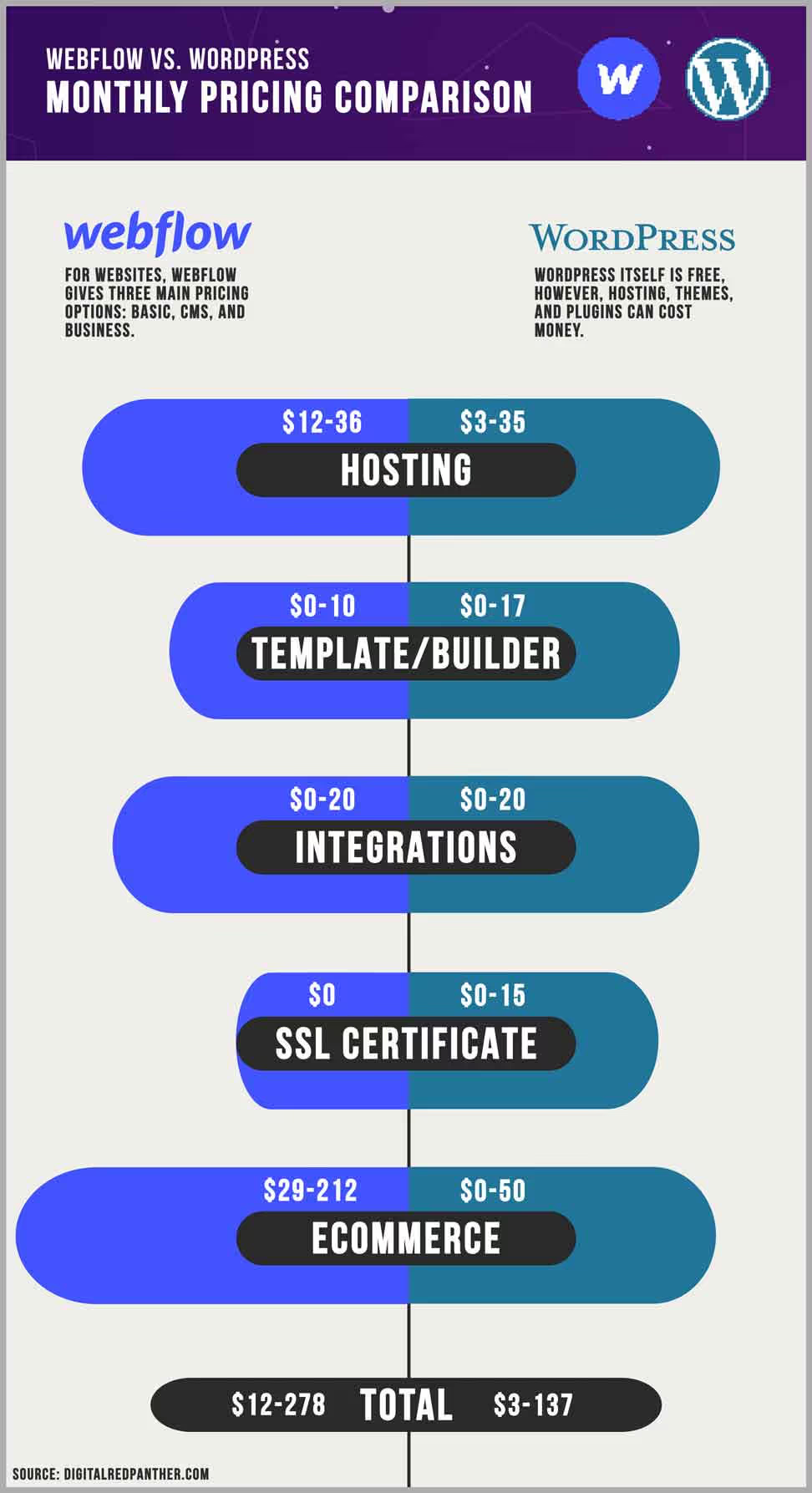
There is a common misconception that Webflow is a lot more expensive than WordPress, when in reality that is not the case.
Technically, you could run a WordPress website for only $3 per month by just paying for hosting and using free themes and plugins.
A lot of websites, utilize paid themes or page builders, so the cost of WordPress and Webflow is quite similar in the end.
Section 3
SEO
As a disclaimer, the website platform itself should not affect your SEO.It is more so how you utilize that platform and which is easiest to do what you need it to.

Webflow SEO:
Webflow comes with its SEO tools built-in. You do not need to install anything to start using them.
This includes:
- Adding title tags and meta descriptions
- Adding Google Analytics and Search Console verification codes to the site
- Updating the social share images and titles
- Generating a sitemap
- Adding 301 redirects
- Minifying code for pagespeed
- Adding info to your robots.txt file
Other SEO functionality, such as Schema markup, you will need to add yourself via custom code.
WordPress SEO:
WordPress allows you to optimize your website for search engines, but you will need to install plugins to accomplish a lot of the most common SEO tasks.
The most common plugins used are Yoast SEO, All in One SEO Pack, WP Rocket, Autoptimize, W3 Total Cache, and so many others that I could go on all day talking about.
Takeaway:
Both WordPress and Webflow come with tools to help you optimize your website for search engines. Neither platform is necessarily all that difficult to implement SEO best practices. Again, it is more so which one you prefer to use.
Section 4
Pagespeed
As a disclaimer, the website platform itself should not affect your SEO.It is more so how you utilize that platform and which is easiest to do what you need it to.

Webflow PageSpeed:
All Webflow websites are hosted on their Tier 1 Content Delivery Network, Amazon CloudFront, and Fastly.
What this means is that they are all-in on pagespeed.

Also, because the websites are being built basically from scratch, the code is not any larger than it needs to be, which is great news for page loading times.

Justin Countryman
Owner
Image Digital Marketing
"Page speed is critical when it comes to creating a great user experience. I used WP and page builder themes for years but I could never get those sites fast enough. I didn’t want to have to hire a developer to create custom themes and didn’t want to have to become a developer to make a fast WP site. Then I found Webflow and I love how the only code that gets created is what I build. My client’s sites are blazing fast now."
Keep in mind, Webflow uses global CSS and javascript files, so if you have a large website, those files need to load on each and every page.
WordPress PageSpeed:
Not all WordPress websites are built the same. Because of this, the pagespeed of WordPress websites depend on several different factors.
Some themes take longer to load, while others are quite fast. However, it’s fairly well known that WordPress websites are quite slow. Some page builders, such as Divi and Elementor, are known to have very slow page loading times, especially on mobile devices.
The amount of plugins you install will also affect how slowly your website loads. You also have to consider which hosting provider you are using, and if you are using a CDN.
The fastest themes are:
- Scalia
- The Gem
- Top SEO
- X Theme
- Udesign
- Skylar
The quickest hosting providers are:
- Pressidium
- Kinsta
- WP Engine
- DreamHost
- InMotion Hosting
- Flywheel
Some common pagespeed plugins which can be used to minify the code and compress large files are WP Fastest Cache, Autoptimize, and WP Rocket.
Takeaway:
It’s hard to argue against the notion that Webflow has a leg up on WordPress in terms of pagespeed.
Brian Dean over at Backlinko conducted an in-depth study of the most popular CMS platforms and found that WordPress ranked near the bottom for pagespeed.
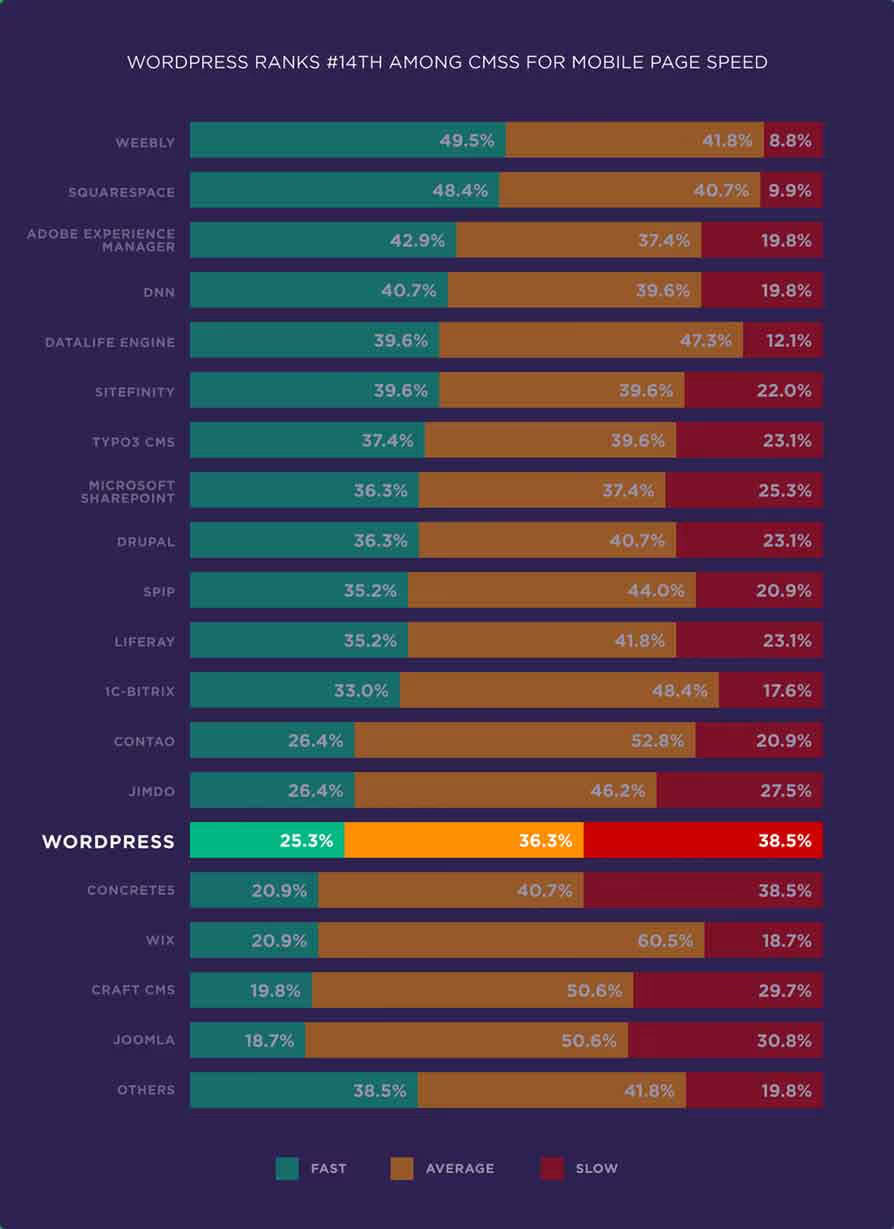
On a side note, Webflow was not included in the study. Is it possible to have a fast loading WordPress website? Absolutely. Can WordPress compete with Webflow on pagespeed? In most instances, no.

Mike Arney
Owner
Halftone Digital
"We're huge Webflow fans (and no, they didn't pay us to write that). Being able to design and build while using Webflow's CMS s an incredibly potent method to design for the web. It makes a site feel real right away–– it IS real right-away. Making changes to the content and layouts on the fly and quickly testing your designs is never not satisfying and clients are seeing the end result as you iterate, not a concept."
Section 5
CMS and Blogging
The Content Management System alone will probably be the deciding factor for a lot of web design agencies.This is because it not only matters how well the platform works for you, but also how easily a client can utilize it.

Webflow CMS and Blogging:
"Is Webflow good for blogs?" is a commonly asked question.
Webflow allows you to easily add, remove, and update pages. In order to add blog posts to a template blog post page, you need to purchase their “CMS” plan. Once you do so, you now have the capability to completely customize the blog post template page.
If you are a web design agency, and the client wanted the ability to go into the CMS and add blog posts, this would be quite simple to set up. You can set up the CMS however you’d like, and all the client has to do is log in and fill in the blanks based on your setup.
Webflow also allows for a great amount of customization with their dynamic CMS capabilities.
For example, if you were creating a homepage and wanted to feature specific CMS pages in specific sections while also featuring particular features about each of those CMS pages individually, you could do so quite easily.
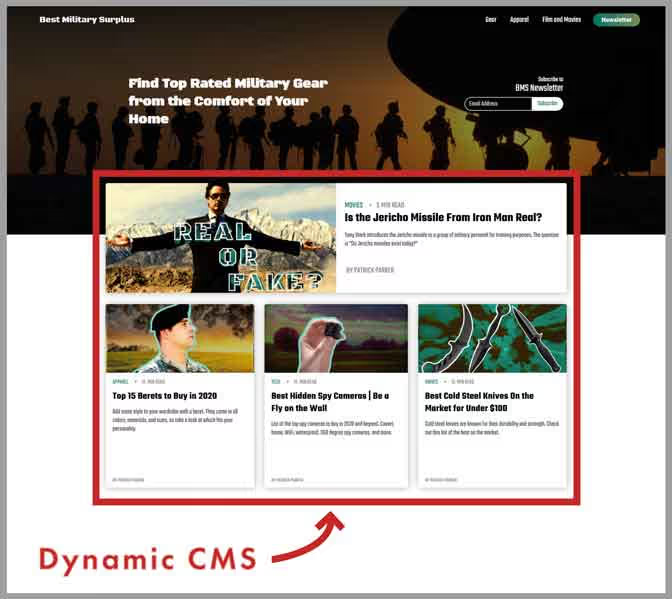
If you like to let your blog readers comment on your articles, Webflow does not have a commenting system built in. You will have to use a third party tool, like Disqus, to do so.
WordPress CMS and Blogging:
WordPress has always been built for blogging. This means that their content management system is fairly simple and easy to use.
Upon entering the backend, you can click “Add a Page” or “Add a Post”, and the rest is set up to take care of itself. You can easily give editor access to specific users, and they can go in and add or edit blog posts or pages at any time.
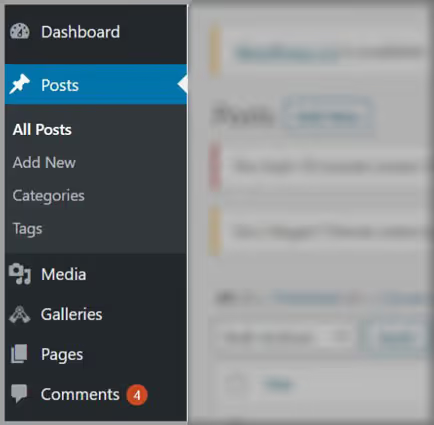
If you are using a pre-built theme, you may not be able to customize the blog post template page. However, this can be done using a page builder theme or plugin.
Takeaway:
There are two areas WordPress beats Webflow:
- Webflow does not allow you to change the name of the URL folder in the URL slug. For example, you could not have a blog post with the URL example.com/my-blog-post. The URL would have to be example.com/blog/my-blog-post.
- You can only create one blog post template page, and that cannot be changed outside of a rich text element. A specific example I run into all the time is wanting to be able to have some of my blog posts include a full width section in specific areas of the post, but because I’ve already set my content to be in a container, I cannot do so. Also, I want to be able to create custom table of contents sections with images, but I cannot do this unless I custom code them (which is what I end up doing).
Simply because the CMS of WordPress is more well known, it will be chosen over Webflow.
Lots of companies want to be able to easily write blogs and articles, and because they’ve used WordPress in the past, it’s easiest to continue using it.
Webflow’s page builder does have more customization capabilities on the blog template page as well as dynamically importing information to other pages.
Section 6
3rd Party Plugins and Integrations
The Content Management System alone will probably be the deciding factor for a lot of web design agencies.This is because it not only matters how well the platform works for you, but also how easily a client can utilize it.

Webflow 3rd Party Plugins and Integrations:
Webflow does not use plugins the same way WordPress does.
There are a few, albeit limited, integrations you can do without custom code, such as Zapier and Google Analytics. But you can also add most other integrations via custom code on individual pages or globally.
Note that you will not be able to preview the 3rd party code until the website is published on staging or the live domain.
WordPress 3rd Party Plugins and Integrations:
WordPress has a wide assortment of 3rd party plugins available to install. As mentioned earlier, the more plugins you install, the more your site will be bogged down, so it’s best to keep them to a minimum.
Plugins can accomplish an assortment of tasks such as SEO, contact forms, pagespeed optimization, anti-spam tools, page builder tools, and more.


Jennifer Strumbel
Owner
Flying Orange
"Our clients have diverse site requirements including such features as active real estate listings, filterable data tables, forms with conditional logic, store locations, photo galleries and e-Commerce capabilities just to name a few. When it comes to choosing the best Content Management Solution (CMS) to meet those needs, Flying Orange selects WordPress because of its many free and purchasable Plugins and 3rd Party integrations. Additionally, we can utilize the Wordpress open-source code to program plugins addressing a client’s unique needs. It gives designers the freedom to create custom functionality with little to no limits."
Takeaway:
WordPress probably has the leg up in this area.
A specific example is, I had a client who needed an event calendar added to the website and only wanted to use a specific plugin called Events Calendar Pro. This plugin is not available to use on Webflow, even by custom code, so my only option was to use WordPress.
It does not happen all that often that you need a specific plugin that only works on WordPress and there is no substitute on Webflow, but when it does, WordPress is your only option.
Section 7
Animation and Interactions
Motion graphics and animation are continuing to take a large part in the web design industry.Let's compare WordPress and Webflow's motion cabailities.
Webflow Motion and Interactions:
2D is great, 3D scenes can only be done via custom code at the moment.
Webflow has built-in tools that allow you to add motion and interactions to just about any element on your website. You can trigger an action based on these triggers:
- Mouse click (tap)
- Mouse hover
- Mouse move over element
- Scroll into view
- While scrolling in view
For example, if you wanted to create a timeline on your website that drew a line as you scrolled down on the page, you can easily do this by creating a “While scrolling in view” trigger. This, along with the capability to update your transform settings, including setting a perspective, allows you to add depth to your animations to make it look like some objects are further away than others.
Another great feature with Webflow is Lottie animations, which allow you to create any animation you want in After Effects and easily import it to your website

WordPress Motion and Interactions:
In ordinary WordPress template themes, the only way to add animations and interactions is through custom CSS and Javascript.
Even page builders like Divi are limited in what they can do with motion. However, recent developments in some page builders, like Elementor, have really stepped up their game in terms of interactions and animations. It doesn't quite hit the par of Webflow level, but it definitely is better than what was available 10, or even five, years ago.
Takeaway:
There really isn’t much of a comparison when it comes to motion and interactions between WordPress and Webflow. Webflow clearly is the answer if you’re looking to add animations to your website without custom code.
Section 8
Hosting
The Content Management System alone will probably be the deciding factor for a lot of web design agencies.This is because it not only matters how well the platform works for you, but also how easily a client can utilize it.

Webflow Hosting:
If you purchase a paid plan, Webflow automatically comes with hosting.
It is self-proclaimed as “world-class speed & reliability”, and for a good reason. You are automatically set up with a web application accelerator, Amazon S3 CDN (content delivery network).
A pro or con, depending on how you look at it, is that you do not have access to FTP, cPanel, or an htaccess file. This could be a bummer if you were migrating a website from another platform that had hundreds or thousands of 301 redirects in their htaccess file, and Webflow only allows you to add 301 redirects one by one, manually. I’ve seen discussion about this in the forums, but it does not seem like this is a feature that will be added anytime soon.

Backups and custom forms are included with Webflow hosting. Email integration is not, however, included. The best solution is to use G-Suite to set up an email account with your domain. Webflow also comes with a free SSL certificate, which is automatically added.
WordPress Hosting:
WordPress does not automatically come with hosting. You will need to choose a hosting provider to use based on your budget and needs.
One thing to consider when purchasing hosting for WordPress is the location of the servers compared to your business. The closer the servers are to your location, generally the faster page load times will be.
You can also get set up with a CDN (content delivery network) like Cloudflare, which is a server network that is located in multiple areas to make sure that the end user gets information sent to them from the nearest location.
WordPress hosting plans usually come with email integration. A lot of the built-in email configurations are subpar, so it’s best to find one that integrates well with Outlook or Gmail.
Also, some hosting plans include free SSL certificates, but others do not.
Some of the most common WordPress hosts are Bluehost, Dreamhost, InMotion, Siteground, HostGator, and WPEngine.
Takeaway:
Webflow is already set up with hosting and has great performance, but more customization can be done with WordPress hosting.
Section 9
Difficulty to Learn
The Content Management System alone will probably be the deciding factor for a lot of web design agencies.This is because it not only matters how well the platform works for you, but also how easily a client can utilize it.

Webflow Difficulty:
Webflow comes with a learning curve, as a beginner would not be able to open 'er up, and build a Mona Lisa of websites.
To start, the user interface is intimidating. When first entering the Webflow backend, someone with a lot of experience with page builders may be able to figure it out, but a newbie will have a tough time knowing where and how to start.
There are so many setting options and customization capabilities that it may be overwhelming to try to build a website without watching several tutorials beforehand.
Webflow is best for someone with intermediate to expert level page builder abilities, but not for the absolute beginner. I also mentioned earlier that without previous coding experience it may take some time getting used to how padding, margin, flex box, and other elements work together.
But with some practice, Webflow is absolutely learnable for developers without coding experience.
WordPress Difficulty:
There is a reason why WordPress is the most common website platform on the planet.
Beginners use WordPress, and experts use WordPress. The most difficult part of using WordPress for beginners is probably setting up the domain with hosting and installing WordPress. The great thing about WordPress is that it can be as simple or as advanced as you like.
Some websites have a simple template theme installed with two plugins, and the website is used only for blogging purposes. Other websites are using custom page builders, have 25 plugins installed, and are used for more advanced activities such as eCommerce.
With that being said, WordPress can still be confusing for an absolute beginner, as it’s not self explanatory what needs to be done upon entering the backend.
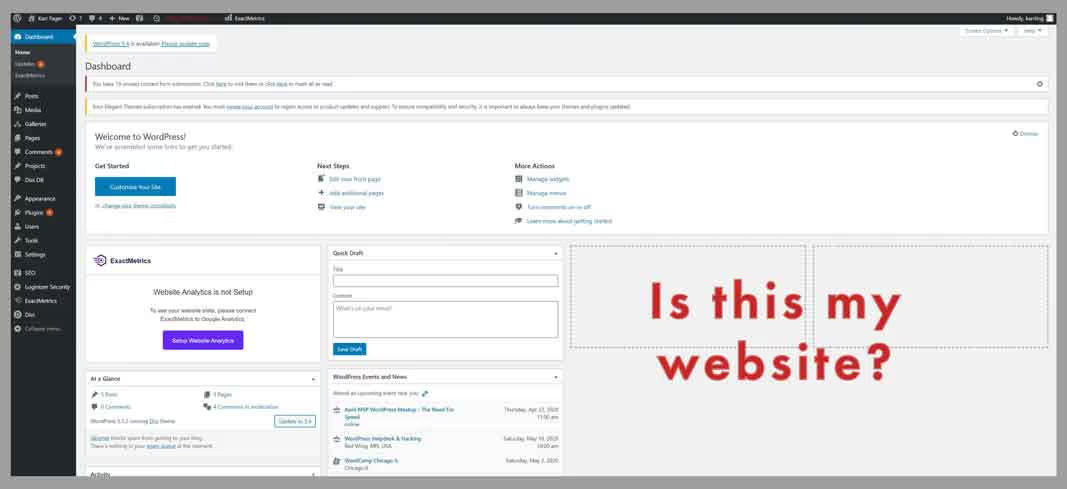

Toby Cryns
President
The Mighty Mo!
"WordPress is best used for either launching basic websites on the cheap, or designing expensive workflow & SEO-optimized business sites. If your needs fall in the middle, or if you require e-commerce, I recommend exploring alternatives to WordPress. Once you get beyond the basics, WordPress is a beast to learn, to optimize, and to maintain."
Takeaway:
Whether using Webflow or WordPress, a beginner will probably not be able to easily use either one of these platforms without reading up some how-to’s and tutorials first.
WordPress is a little easier to learn than Webflow for beginners. However, the intermediate or expert shouldn’t have a difficult time with either of these platforms.
Section 10
eCommerce
Both WordPress and Webflow allow you to sell commerce.Let's compare the two.

Webflow eCommerce:
The biggest perk of doing eCommerce on Webflow is the ability to customize. You can customize the cart and checkout pages to match the rest of your website. You can also customize the emails that get sent out to buyers to confirm purchases. Webflow has integrations with Paypal, Stripe, Apple Pay, and Google Play. There are three different prices for Webflow eCommerce:
Standard = $29 per month, 2% transaction fee, $50k yearly sales volume
Plus = $74 per month, 0% transaction fee, $200k yearly sales volume
Advanced = $212 per month, 2% transaction fee, Unlimited yearly sales volume
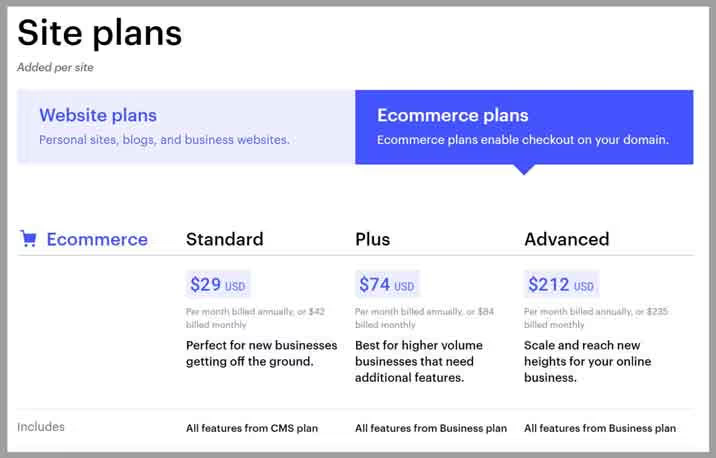
WordPress eCommerce:
WooCommerce is the most popular eCommerce plugin used on WordPress. This plugin allows you to add and edit products with relative ease.
You can also customize your eCommerce shopping experience on Wordpress with plugin extensions, which cover just about any need you can think of. The plugin itself is completely free, but you can pay for additional extensions if needed.

Bryan Hoffman
Owner
Cinch Web Services
"While WordPress does not have e-commerce functionality out of the box, it's the backbone for one of the most popular and powerful e-ccommerce platforms: WooCommerce. WooCommerce can power a wide variety of online stores, including memberships and subscriptions, booking and reservations, digital goods and content, and of course physical goods. There really isn't a limit on what you can sell with WooCommerce. It integrates well with a ton of systems, and plays nicely with analytics and SEO systems. WordPress and WooCommerce are a solid choice for a robust platform to run your online store."
Takeaway:
WordPress’s eCommerce platform is a little easier to use than Webflow for beginners. Webflow’s dynamic CMS capabilities are incredibly useful for someone who has practice with them, but not for the average consumer.
Section 11
Staging
Staging is the ability to test and preview changes made to your website without making those changes to your live domain.It is an important capability, and it's something that I needed about 358 times in the process of making this article.

Webflow Staging:
All Webflow websites automatically come with a Webflow subdomain for staging purposes. At any point in time, whether your website is live or not, you can make updates and test those updates on a preview version of your website without the end user being able to see them.
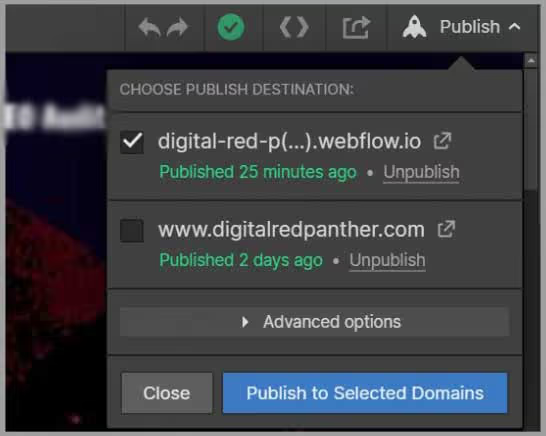
WordPress Staging:
With WordPress, there are generally two options for staging a website:
- You can use your hosting company’s 1-click staging option if they offer it.
- Manually set it up.
This article describes in-depth how to set up staging on your WordPress website.
Takeaway:
Both WordPress and Webflow offer staging options for your website. Webflow comes with this feature out of the box, and WordPress allows you to set this up through your hosting company with a few clicks or manual setup.
Section 12
Technical Support
Technical support is great to have, not only for beginners, but for all web developers.No one knows EVERYTHING about platform, so it's great when you can go somewhere to get questions answered.

Webflow Technical Support:
Webflow offers a couple ways to get support. They have a community support forum, which is filled with designers and developers who use Webflow as well as Webflow team members.
They also allow you to email the support team directly with a ticket, and a member of their team will work with you to resolve your situation.
WordPress Technical Support:
WordPress does not directly offer support. You can find answers to questions by searching community forums and sifting through the extensive amount of information that is currently out there about WordPress.
You can also contact your hosting company for support, but they generally don't help with WordPress-related issues unless you pay for it.
Takeaway:
Because WordPress has been around for longer and is more popular than Webflow, it can be quite easy to find answers to your questions.
However, I find the quality of answers to be better from Webflow’s support system, as they are all-in on the community forum as well as creating superb quality explainer videos.
I still see a lot of companies and agencies deciding to go with WordPress simply because it is more widely known, and it can integrate with the tools they are already familiar with. And to be fair, that actually makes business sense. Webflow takes time to learn, and not all business owners will be in favor of taking the time to do so.

The end user really doesn’t care which website platform you use. Choosing either WordPress or Webflow will not be the deciding factor if your website has a beautiful design or if it ranks #1 on Google. It is more so which one is easiest for you to use and which will allow you to create the best product.
There are ways to integrate WordPress together with Webflow if you're interested.
If you have a different opinion about something, please share it below. Just like most authors, I love criticism ;)




